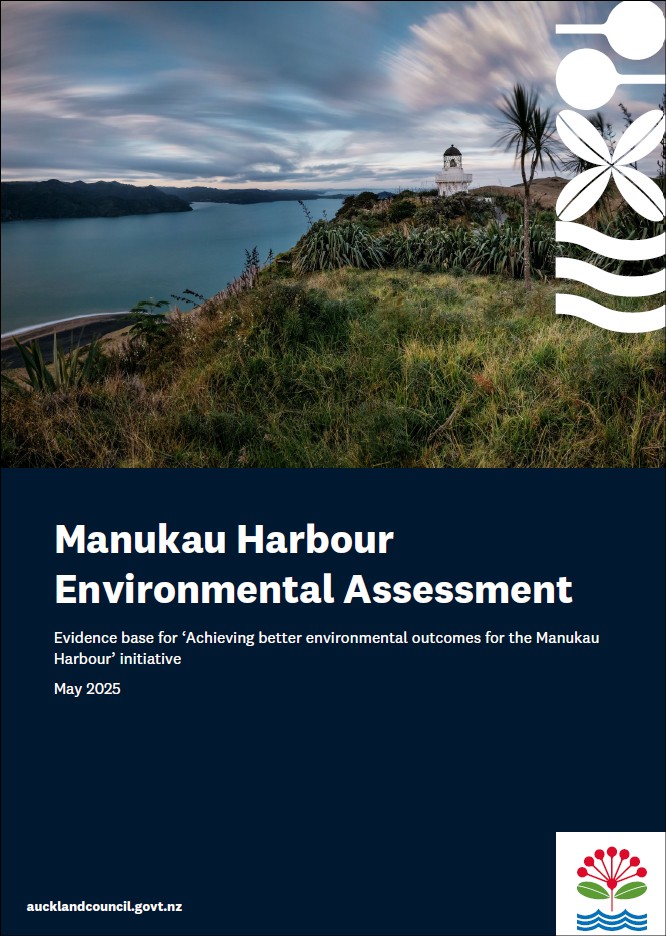Manukau Harbour environmental assessment
Author:
Georgina Hart, Andrew Bird, David Clelland, Auckland Council Natural Environment Strategy UnitSource:
Auckland Council Policy Department, Natural Environment Strategy UnitPublication date:
2025Topics:
EnvironmentManukau Harbour environmental assessment. Evidence base for ‘Achieving better environmental outcomes for the Manukau Harbour’ initiative, May 2025
Executive summary, extracts
Auckland Council is establishing strategic direction for its departments and council-controlled organisations to achieve better environmental outcomes for the Manukau Harbour, in recognition of the significant statutory role that the council has to ensure natural environment outcomes for harbours. This report is one in a series of supporting documents that identify the evidence base for the development of this strategic direction.
An assessment of drivers, pressures, state, impacts, and response in relation to the environmental health of the Manukau Harbour has been applied to identify:
- potential gaps in the council’s environmental management for the harbour
- priority focus areas for setting SMART objectives to achieve five adopted environmental outcomes for the harbour.
Drivers and pressures
Auckland Council influences local scale drivers for the Manukau Harbour. For example, decisions related to environmental regulation, waste management, water services, land use zoning and transport infrastructure influence Manukau Harbour local scale drivers and pressures that can result in changes to the harbour’s state. In particular, how growth and infrastructure are delivered, and their long-term impacts are highlighted as a key driver of pressures on the harbour’s health.
The combination of catchment and harbour characteristics, its mix of rural and urban land uses, and proximity to the large population base of Tāmaki Makaurau / Auckland has resulted in a suite of land-based pressures altering the state of the harbour and causing a variety of environmental, social, and cultural impacts. ...
Key messages on the environmental health of the Manukau Harbour
- Some marine and coastal habitats are in good health while others are not.
o The mud and sandflats in the main body of the harbour are considered in good health - supporting a diversity of life and providing food sources for the many bird species that visit the harbour.
o Historic loss of seagrass and saltmarsh habitat has not yet recovered.
o Sedimentation has been building up on the seafloor in the harbour’s inlets over a long period, which has reduced the diversity of benthic life in the inlets, which has numerous flow on impacts on life in the harbour. - The Manukau Harbour is recognised as a nationally and internationally significant bird habitat because of the numbers and diversity of bird species; as well as the high numbers of endemic and threatened bird species present. Wading and seabirds face many pressures while in the harbour including habitat loss, pest animals, plastics, and disease.
- Commercially fished species’ populations are believed to be relatively stable. However, limited information on finfish and shellfish populations in the harbour was identified. In relation to shellfish, monitoring of pipi and cockles at two locations reported low numbers.
- Most beaches around the Manukau Harbour are considered safe for swimming most of the time (24/29 beaches assessed).
- Organic contaminants, arsenic, mercury, copper and lead are not found in concerning levels in the harbour.
- Water quality is poor in the harbour’s inlets due to elevated sediment and nutrient. Water quality is poorest in and around Māngere Inlet. Algal blooms that would be expected with the levels of nutrient observed are not regularly occurring, because of the light limiting impact of sediment in the water.
- Microplastics have been found at high levels in the sediments of Manukau Harbour beaches, compared to Kaipara and Waitematā harbour beaches.
- Climate change is affecting the harbour, including increased sea surface temperature, ocean acidification and rising sea levels. Climate impacts on marine species and habitats will increase over the century.
- Primary marine invasive species of concern are not found in the harbour; however, marine invasive species pose a future risk that requires ongoing focus.
- Toxoplasmosis from cats is present in the harbour and Tasman Sea and threatens Māui dolphins of which there are ~54 remaining. ...
Auckland Council, May 2025
